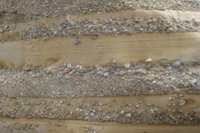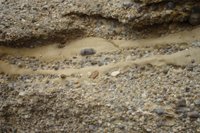



Carmelo Formation (Paleocene: 60,000,000 years old)
Around 60 million years ago, the Salinian block subsided and ocean waters filled the granodiorite canyons. On land, ancient rivers carried lava from distant volcanoes down to the shoreline, and along the way scoured it into rounded pebbles and cobblestone-sized rocks. Over time, these rocks and layers of sand were deposited on the submarine canyon walls by underwater landslides and eventually cemented into a conglomerate called the Carmelo Formation. For many people, the Carmelo Formation is the most interesting type of rock at Point Lobos. It is softer than the granodiorite and is easily seen along the south shore of the reserve, where it has been eroded by ocean waves to form a photogenic series of coves, crevices and shelves.
The Carmelo formation is composed of thousands of layers of conglomerate, sand stone, and mudstone which the turbidity currents have deposited. The mudstone was deposited as marine mud. Most pebbles in the conglomerate are of volcanic origin. Conglomerate and sandstone are shades of brown, with concentrations of reddish brown iron oxide common in the sandstone. Mudstone is gray.

sandstone formations
source: http://pt-lobos.parks.state.ca.us/ (Jeff Thomson)
fotos: Gertjan Laurenssen















No comments:
Post a Comment